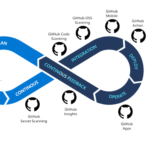The way organizations manage and deploy their IT infrastructure has undergone a revolutionary transformation. Gone are the days of manual server setups and error-prone configuration processes. Enter Infrastructure as Code (IaC) - a game-changing approach that automates infrastructure provisioning and management using code. This blog post dives deep into the critical role IaC plays in modern DevOps pipelines, showcasing practical examples with Terraform and Ansible, comparing these tools, and sharing best practices to empower your infrastructure automation journey.
What Is Infrastructure as Code (IaC)?
Infrastructure as Code is a methodology that treats infrastructure setup-servers, networks, databases, and more-as software. Instead of manually configuring hardware or cloud resources, teams write declarative or imperative code to define and provision infrastructure automatically. This approach brings software development principles like version control, testing, and continuous integration to infrastructure management.
Key benefits of IaC include:
- Speed: Rapid provisioning and scaling of infrastructure.
- Consistency: Eliminates configuration drift and human errors.
- Reproducibility: Easily replicate environments for development, testing, and production.
- Collaboration: Infrastructure code can be reviewed, versioned, and audited.
IaC in Modern DevOps Pipelines
DevOps aims to unify development and operations to accelerate software delivery with high quality. IaC is foundational to this by enabling automated, repeatable infrastructure deployments integrated into CI/CD pipelines. Infrastructure provisioning becomes part of the same automated workflow as application code deployment, reducing delays and manual handoffs.
Typical DevOps pipeline stages enhanced by IaC:
- Code Commit: Developers push infrastructure code to version control (e.g., Git).
- Automated Testing: Infrastructure code is validated with linting, syntax checks, and unit tests.
- Build & Plan: Tools generate execution plans showing infrastructure changes.
- Approval & Apply: Changes are reviewed and applied automatically or manually.
- Monitoring & Feedback: Continuous monitoring ensures infrastructure health and compliance.
Popular IaC Tools: Terraform and Ansible
Among many IaC tools available, Terraform and Ansible stand out for their widespread use, versatility, and complementary capabilities. Understanding their strengths and differences helps teams choose the right tool or combination for their needs.
Terraform Overview
Terraform, developed by HashiCorp, is a declarative IaC tool designed for provisioning and managing infrastructure across multiple cloud providers and on-premises environments. Using HashiCorp Configuration Language (HCL), users describe the desired state of resources, and Terraform handles the orchestration to reach that state.
Ansible Overview
Ansible, an open-source tool by Red Hat, is primarily a configuration management and automation tool that can also provision infrastructure. It uses YAML-based playbooks to define tasks and configurations, focusing on procedural steps to configure systems and deploy applications.
Practical Examples of IaC Deployments
Terraform Deployment Examples
1. Deploying a Simple AWS EC2 Instance with Terraform
provider "aws" {
region = "us-east-1"
}
resource "aws_instance" "example" {
ami = "ami-0c94855ba95c71c99" # Amazon Linux 2 AMI
instance_type = "t2.micro"
tags = {
Name = "TerraformExample"
}
}
This script provisions a basic EC2 instance in AWS. Running terraform init, terraform plan, and terraform apply will create the instance automatically.
2. Deploying an Azure Virtual Machine with Terraform
provider "azurerm" {
features {}
}
resource "azurerm_resource_group" "example" {
name = "example-resources"
location = "East US"
}
resource "azurerm_virtual_network" "example" {
name = "example-vnet"
address_space = ["10.0.0.0/16"]
location = azurerm_resource_group.example.location
resource_group_name = azurerm_resource_group.example.name
}
resource "azurerm_subnet" "example" {
name = "internal"
resource_group_name = azurerm_resource_group.example.name
virtual_network_name = azurerm_virtual_network.example.name
address_prefixes = ["10.0.2.0/24"]
}
resource "azurerm_network_interface" "example" {
name = "example-nic"
location = azurerm_resource_group.example.location
resource_group_name = azurerm_resource_group.example.name
ip_configuration {
name = "internal"
subnet_id = azurerm_subnet.example.id
private_ip_address_allocation = "Dynamic"
}
}
resource "azurerm_linux_virtual_machine" "example" {
name = "example-machine"
resource_group_name = azurerm_resource_group.example.name
location = azurerm_resource_group.example.location
size = "Standard_B1s"
admin_username = "adminuser"
network_interface_ids = [
azurerm_network_interface.example.id,
]
admin_ssh_key {
username = "adminuser"
public_key = file("~/.ssh/id_rsa.pub")
}
os_disk {
caching = "ReadWrite"
storage_account_type = "Standard_LRS"
}
source_image_reference {
publisher = "Canonical"
offer = "UbuntuServer"
sku = "18.04-LTS"
version = "latest"
}
}
This script creates a resource group, virtual network, subnet, NIC, and a Linux VM in Azure.
Ansible Deployment Examples
1. Provisioning an AWS EC2 Instance with Ansible
- name: Launch EC2 instance on AWS
hosts: localhost
connection: local
gather_facts: no
tasks:
- name: Launch instance
amazon.aws.ec2_instance:
name: "AnsibleExample"
key_name: "my-key"
instance_type: t2.micro
image_id: ami-0c94855ba95c71c99
wait: yes
region: us-east-1
register: ec2
2. Deploying a VM on Azure with Ansible
- name: Create Azure VM
hosts: localhost
connection: local
tasks:
- name: Create resource group
azure.azcollection.azure_rm_resourcegroup:
name: example-resources
location: eastus
- name: Create virtual network
azure.azcollection.azure_rm_virtualnetwork:
resource_group: example-resources
name: example-vnet
address_prefixes: 10.0.0.0/16
- name: Create subnet
azure.azcollection.azure_rm_subnet:
resource_group: example-resources
name: internal
address_prefix: 10.0.2.0/24
virtual_network: example-vnet
- name: Create VM
azure.azcollection.azure_rm_virtualmachine:
resource_group: example-resources
name: example-vm
vm_size: Standard_B1s
admin_username: azureuser
ssh_password_enabled: false
ssh_public_keys:
- path: /home/azureuser/.ssh/authorized_keys
key_data: "{{ lookup('file', '~/.ssh/id_rsa.pub') }}"
image:
offer: UbuntuServer
publisher: Canonical
sku: 18.04-LTS
version: latest
3. Configuring On-Premises Servers with Ansible
Ansible excels at configuring existing servers, whether on-premises or cloud-based. For example, installing and configuring NGINX on a fleet of Linux servers:
- name: Install and configure NGINX
hosts: webservers
become: yes
tasks:
- name: Install NGINX
apt:
name: nginx
state: present
update_cache: yes
- name: Ensure NGINX is running
service:
name: nginx
state: started
enabled: yes
- name: Deploy custom NGINX config
copy:
src: ./nginx.conf
dest: /etc/nginx/nginx.conf
owner: root
group: root
mode: 0644
- name: Reload NGINX
service:
name: nginx
state: reloaded
Comparing Terraform and Ansible: Pros and Cons
| Feature | Terraform | Ansible |
|---|---|---|
| Primary Use | Provisioning and managing infrastructure resources declaratively | Configuration management, application deployment, and some provisioning |
| Language | HCL (declarative) | YAML (imperative/procedural) |
| State Management | Maintains state file to track resource changes | No native state management; idempotent tasks |
| Cloud Support | Extensive multi-cloud provider support | Good cloud modules, but primarily for configuration |
| Idempotency | Ensures desired state via plan and apply | Idempotent playbooks ensure consistent configuration |
| Learning Curve | Requires learning HCL and state concepts | Easy to learn YAML, but complex playbooks can grow |
| Community & Ecosystem | Strong ecosystem with many providers and modules | Large collection of modules and roles, strong community |
| Best For | Infrastructure provisioning, multi-cloud orchestration | Configuration management, application deployment, on-prem automation |
Best Practices for Using Terraform and Ansible Together
Many organizations combine Terraform and Ansible to leverage their strengths: Terraform for provisioning infrastructure and Ansible for configuring software and services on that infrastructure.
- Separate Concerns: Use Terraform to create infrastructure resources (VMs, networks, storage) and Ansible for post-provisioning configuration.
- Manage State Securely: Store Terraform state files remotely and securely (e.g., AWS S3 with locking via DynamoDB) to enable team collaboration.
- Modularize Code: Break Terraform and Ansible code into reusable modules and roles for maintainability.
- Version Control: Keep all IaC code in Git repositories with proper branching and pull request workflows.
- Automate Testing: Use tools like Terratest or kitchen-terraform for Terraform and Molecule for Ansible to validate code changes.
- Use Variables and Secrets Management: Parameterize your code and manage secrets securely using tools like HashiCorp Vault or AWS Secrets Manager.
- Integrate with CI/CD: Automate Terraform and Ansible runs in your pipeline with appropriate approval gates.
Challenges and Solutions in IaC Adoption
Challenges:
- State Management Complexity: Terraform’s state files can become a bottleneck without proper remote state management.
- Learning Curve: Teams need to upskill in new languages and paradigms.
- Tool Overlap: Confusion over when to use Terraform vs. Ansible.
- Security Risks: Managing secrets and credentials safely is critical.
- Drift Detection: Ensuring infrastructure remains consistent with code over time.
Solutions:
- Use remote backends with locking for Terraform state.
- Invest in training and documentation.
- Define clear roles for each tool in your workflow.
- Leverage secret management tools and environment variables.
- Implement monitoring and drift detection tools.
Future Outlook and Emerging Trends in IaC
The IaC landscape continues to evolve rapidly with trends such as:
- GitOps: Using Git repositories as the single source of truth for infrastructure and application deployments, enabling fully automated pipelines.
- Policy as Code: Integrating compliance and security policies directly into IaC workflows using tools like Open Policy Agent (OPA).
- Multi-Cloud and Hybrid Cloud Automation: Increasing adoption of IaC tools that seamlessly manage resources across diverse environments.
- AI and Automation Enhancements: Leveraging AI for intelligent recommendations, error detection, and automated remediation in IaC.
- Serverless and Container Infrastructure IaC: Expanding IaC capabilities to manage serverless functions and Kubernetes clusters declaratively.
Real-World Examples
Example 1: HashiCorp’s Own Use of Terraform
HashiCorp uses Terraform extensively to manage its cloud infrastructure, enabling rapid scaling and multi-cloud deployments. Their open-source modules and best practices have influenced the IaC community widely.
More details: Terraform Enterprise Case Study
Example 2: Netflix’s Use of Ansible
Netflix employs Ansible for configuration management and application deployment across its vast fleet of servers, ensuring consistent environment setup and rapid rollout of updates.
More details: Netflix Ansible Case Study
Conclusion
Infrastructure as Code is no longer optional but essential for modern DevOps success. Tools like Terraform and Ansible empower teams to automate infrastructure provisioning and configuration, reducing errors, accelerating delivery, and improving collaboration. By understanding their strengths, combining them effectively, and following best practices, organizations can build resilient, scalable, and secure infrastructure pipelines. As IaC continues to evolve with trends like GitOps and policy as code, staying informed and adaptable will keep your DevOps pipeline cutting-edge.
Further Reading & References
- Terraform Official Documentation
- Ansible Official Documentation
- Terraform Enterprise Case Study
- Netflix Ansible Case Study
- GitOps: The Future of IaC
- Infrastructure as Code: Managing Servers in the Cloud by Kief Morris (O'Reilly Media)
If you are ready to transform your infrastructure management and accelerate your DevOps journey, reach out to expert consultants who can tailor solutions to your needs.
Contact us today to get started with Infrastructure as Code and modern DevOps automation!



